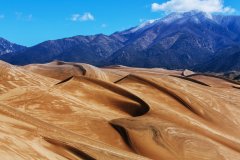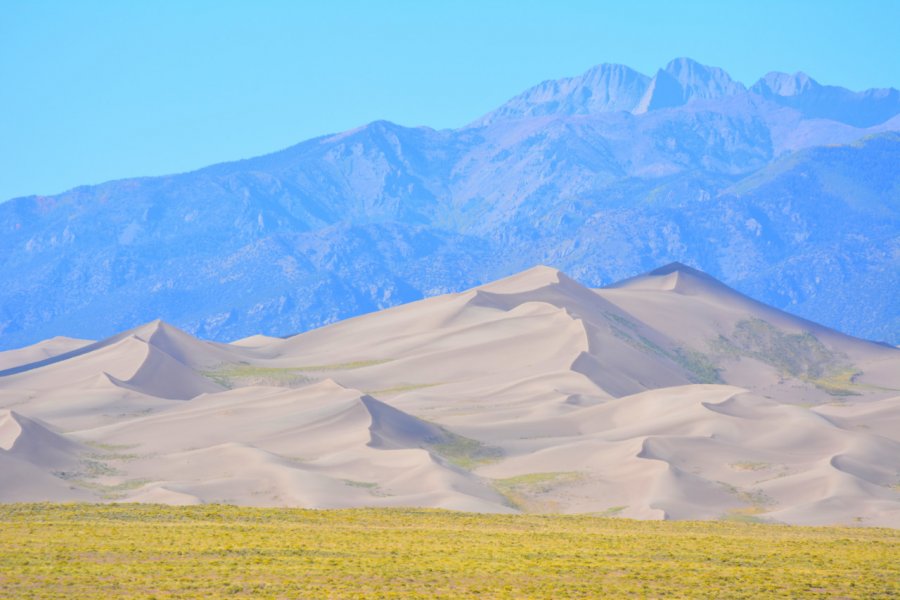Travel Guide Great Sand Dunes National Park
Find an accommodation
Advertising
Sand dunes that are drawn between a desert valley and the Cristo Mountains' cut-cut landforms, is the unlikely and magical setting of Great Sand Dunes National Park. The road to join the park is already part of the adventure and will allow you to cross desert landscapes before plunging into an infinitely right road. Then, all of a sudden, you will see these beautiful gold dunes that take place in contrast to the green mountains in the background. If you have little time in front of you, spend a few hours exploring sand dunes and plan to climb one of them to observe the sunset or sunrise. Depending on the season, also plan a swim in the watercourse at the bottom of the dunes and, if you have more time ahead, plan to hike in the different parts of the park to report on its incredible diversity and enjoy unique panoramas.GeologyThe San Luis Valley is the result of various natural phenomena: the removal of a large lake (called Alamosa Lake as the main city of the surrounding area) formerly covering the region and other smaller water points leaving behind a layer of sand and a few wetlands still present (called sabkha), but also the creation of the Cristo Sangre chain, raised by the rotation of a plaque. tectonic or the creation of the reliefs of San Juan, west of the valley, following volcanic activity. Millions of years ago, the sand left by the rivers was swept away by the winds of the San Louis Valley against the mountain foothills of Cristo's Sangre, now forming the highest dunes in North America, the highest of which is 220 meters tall.HistoryThe first inhabitants are nomadic hunter-gatherers dating back to the age of the stone age. The Utes then populate the region and call the Great Sand Dunes "Saa waap maa nache" (sand moving). Then it is the settlers' turn to discover spectacular formations. In 1806, Zebulon Pike and his men crossed the Sangre of Cristo Mountains and fell by surprise with the white sand dunes. In 1875, the Herard family moved to Medano Creek and lived with livestock soon joined by a few other farm families. Then the gold rush attracts the Great Sand Dunes and builds infrastructure to extract the precious ore. Fortunately, the premises are beginning to realize the uniqueness of geological formations and the preservation of the site. On March 17, 1932, President Herbert Hoover created the national park which originally provides for the protection of 15,000 hectares. Today, the site includes 60,000 hectares of dunes, prairies and mountainous areas.ClimateA desert region of altitude, the Great Sand Dunes are characterized by an extreme climate with very large temperature differences. Summer days are warm and cool nights, winter temperatures can fall to almost -20 ° C. If autumn is mild, spring is cool and windy, with March being the most snowy period of the year.NatureThe park is not limited to dunes and hosts several ecosystems: a mountain slope, sand dunes, prairies and wetlands: the sabkhas. It is a natural treasure, home to a very diverse fauna and flora specific to each ecosystem. Among the most wild animals, the black bear and the puma populate the mountainous part. A herd of 1,500 bison is high in the park. On the vegetation side, you will see many alpine and subalpine flowers.
What to visit Great Sand Dunes National Park?
Suggested addresses Great Sand Dunes National Park
Weather at the moment
Advertising
Organize your trip with our partners Great Sand Dunes National Park
Transportation
Book your plane tickets
Car Rental
Boat rental
Accommodation & stays
Find a hotel
Holiday rental
Find your campsite
Tailor-made trip
Immersion travel
Services / On site
Activities & visits
Find a doctor
Find unique Stay Offers with our Partners
Pictures and images Great Sand Dunes National Park
Other destinations nearby Great Sand Dunes National Park
100 km away






